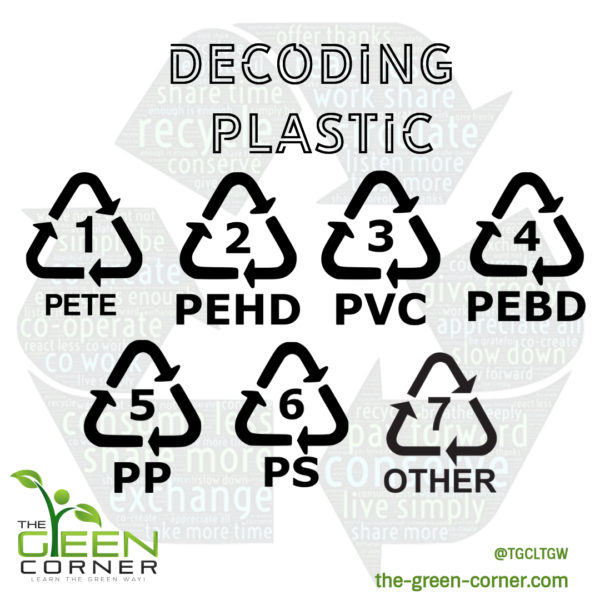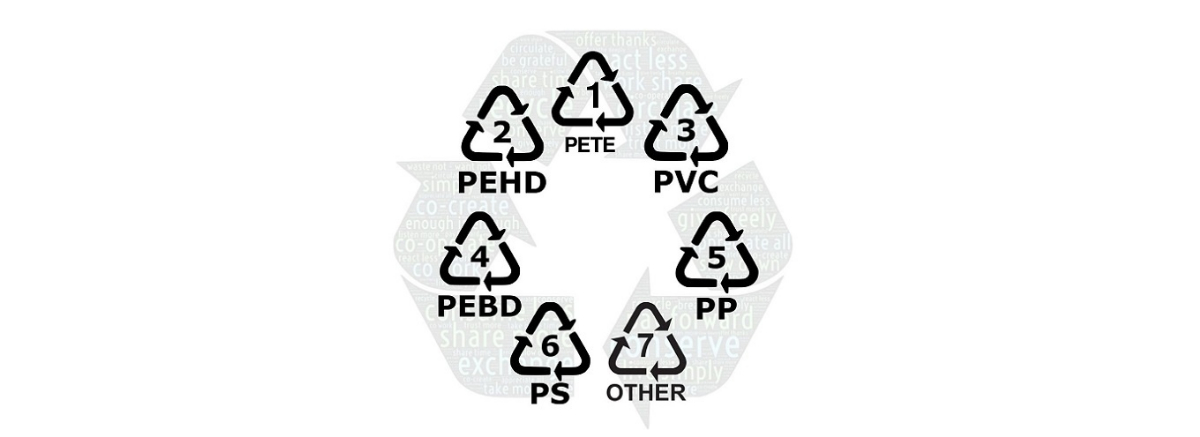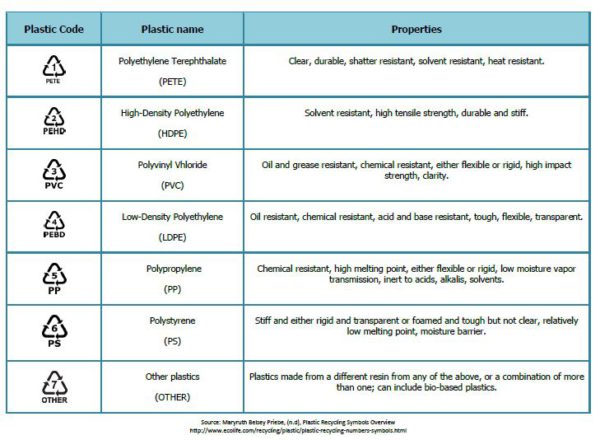Decoding Plastic
Let’s talk about recycling plastic. I bet you are probably not surprised to hear about recycling but to be clear we’ll be discussing the different codes used for recycling plastic.
WHAT IS PLASTIC?
First, let’s define plastic. Plastics according to EcoLife are human-made synthetic polymers made from long chains of carbon and other elements. Through a process called cracking, crude oil, and natural gases are converted to hydrocarbon monomers like ethylene, propylene, styrene, vinyl chloride, ethylene glycol, and so on. These are then mixed with other chemicals to produce a desired finished product, plasticizers like phthalates to make PVC soft, butadiene to make plastic code 7 tough, and many others. Additional additives include bacteria, heat, light, color, and friction. To create the desired form and shape of the plastic, the materials are finally cast, spun, molded, fabricated, extruded, or applied as a coating on another material.
PLASTIC IS EVERYWHERE
Plastics can be found everywhere in our lives, in our homes, our vehicles, our clothes, and even inside our own bodies. It is not an exaggeration, plastic is part of a lot of products we use like cases for electronics, vending machine cups, food packaging, food containers, refrigerator liners, beverage containers, and bottles, cleaning product containers, hair products, product containers, shopping bags, cabling, pipes, wood composites, produce bags, flexible food containers, shrink wrap, lining for cardboard, wire coverings, toys, cookware and dishes, moldings, toys, insulation for electronics, lamination for paper, nylon materials, car moldings, fishing line, toothbrushes, beverage bottles, DVDs and CDs, CD and DVD cases, eyeglasses and contact lenses, traffic lights, lenses, textiles, medical implants, aerospace parts, food film, microwaveable packages, biodegradable beverage bottles, and dishes, light diffusers for vehicles, Plexiglas, large and small appliances, auto parts, pipes, foam products, coatings for fry pans (Teflon) and water slides, shower curtains, flooring, and windows.
THE PLASTIC CODES
The world of plastics can seem at times overwhelming or like a complete mystery. It is difficult to plan to recycle when there are many types of plastics of which many are not properly labeled. But when plastic recycle numbers (codes) are available, learning how to read them will help you decide which products to consume:
Plastic Code 1 is called Polyethylene Terephthalate (PETE). Its properties are the following: clear, durable, shatter-resistant, solvent-resistant, and heat-resistant. This plastic can be found in beverage containers (soda, water, beer), food containers (ketchup, salad dressing, peanut butter, jam), oven film, microwave trays, carpeting, textiles, and strapping.
Plastic Code 2 is called High-Density Polyethylene (HDPE). Its properties are the following: solvent-resistant, high tensile strength, durable and stiff. This plastic can be found in beverage containers (milk, water, juice), cosmetic and cleaning product containers (shampoo, laundry detergent, all-purpose cleaners), cereal box liners, thin-film plastic shopping bags, pipe and conduit, wood composites, wire, and cable coverings.
Plastic Code 3 is called Polyvinyl Chloride (PVC). Its properties are the following: oil and grease-resistant, chemical-resistant, either flexible or rigid, high impact strength, and clarity. This plastic can be found in Blister packs and clamshells, pipe, siding, window frames, decking, bags for textiles (bedding), food shrink wrap, medical equipment (tubes, blood bags), wire insulation, and flooring.
Plastic Code 4 is called Low-Density Polyethylene (LDPE). Its properties are the following: oil-resistant, chemical-resistant, acid, and base resistant, tough, flexible, and transparent. This plastic can be found in Clear plastic bags (dry cleaning, bakery goods, produce, household garbage), food container lids, flexible food containers (squeezable honey), shrink wrap, used as a coating in paper milk cartons and paper coffee cups, adhesives, sealants, wire coverings.
Plastic Code 5 is called Polypropylene (PP). Its properties are the following: chemical resistance, high melting point, either flexible or rigid, low moisture vapor transmission & inert to acids, alkalis, and solvents. This plastic can be found in food containers (yogurt, deli foods, margarine, ketchup, syrup), medical containers, bottle caps, carpeting, and automotive parts.
Plastic Code 6 is called Polystyrene (PS). Its properties are the following: stiff and either rigid and transparent or foamed and tough but not clear, relatively low melting point, and moisture barrier. This plastic can be found in Foodservice items (cups, plates, bowls, take-out containers, meat trays), packing material (furniture, electronics, shipping containers as loose-fill), CD and DVD cases and video cartridges, medicine bottles, medical products, toys, electronic housing.
Plastic Code 7 is called Other Plastics (OTHER). Its properties are the following: plastics made from a different resin from any of the above or a combination of more than one; can include bio-based plastics. It’s difficult to say where specifically you can find this plastic unless the resin used is known.
By now we know about the 7 codes and one would think recycling is the solution to the current plastic problem. Unfortunately, we have passed the time when it has actually been the main practical solution.
According to Laura Parker from National Geographic, plastic takes more than 400 years to degrade, so most of it still exists in some form. Today only a small percentage of all plastic is recyclable. Another small portion is burned generating the air pollution in the process. A large percentage is dumped in landfills, forests, and the ocean. So what now?
REDUCE PLASTIC
We have to figure out a way to reduce the import of plastic. In most countries only Code 1 is recyclable. The other types of plastic are also recyclable depending on the plastic composition but the cost of it is high so most countries don’t choose recycling programs for these plastics.
By raising environmental taxes on plastics that are not recyclable, the products will become more expensive. Corporations will most likely do something if they experience financial losses. To be realistic some companies don’t really care about being publicly exposed as giant polluters because they are financially stable.
We as consumers need to be more informed and become more responsible. Let’s be honest, if I’m in a rush and need to buy some stuff at the closest grocery store. I’m not going to be looking at the product from top to bottom. I only look at the expiration date. I have to change this behavior. But how?
I think it would help to have a list of products that have the coding 3 through 7. I would be able to recognize the brand and know it is not an option for me anymore. You don’t even realize you have used this toxic plastic for so long. I saw this with my hair products. Most of them are code 5, even the plastic coffee mugs replacement for the coffee cups at Starbucks is code 5 as well. Most of it is imported and in my country plastic code 5 is a non-recycle and most probably will end up in landfills. Since the import of codes 3 to 7 is higher than the import of codes 1 and 2, only focusing on recycling won’t solve the problem. So what can we do?
Let’s expose all those brands using code 3 to 7 plastics and stop buying them. Some companies will listen when their earnings are not growing as expected. Other more effective ways are establishing government legislation that includes sanctions against plastic production like environmental taxes. I am very clear that even though there are more effective ways, the probability of it actually happening at the moment is close to zero. At this moment the fossil fuel industry has powerful defenders that are able to influence governments around the world. But if the communities come together, and make loud noise the government will eventually listen.
Until then let’s work together to inform people about the different sorts of plastics and raise awareness of the damage we are inflicting on ourselves and future generations. Let’s take a moment and look into our cabinets.
So? What did you find? Share the brand name, and code of the product with us. We all can learn from each other.

.
Sources
Life cycle of a plastic product. (n.d.). Retrieved July 8, 2010, from American Chemistry Council: http://www.americanchemistry.com/s_plastics/doc.asp?CID=1571&DID=5972
An introduction to plastics. (n.d.). Retrieved July 7, 2010, from Calibre Plastics: http://www.calibre.co.nz/plasticc.htm
What is Plastic Made of? (n.d.). Retrieved July 7, 2010, from EcoLife; A Guide to Green Living: http://www.ecolife.com/recycling/plastic/what-plastic-made-of.html
A whopping 91% of plastic isn’t recycled (December 20, 2018), Laura Parker from National Geographic:
https://news.nationalgeographic.com/2017/07/plastic-produced-recycling-waste-ocean-trash-debris-environment/

